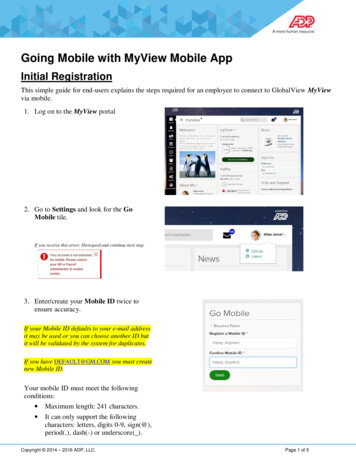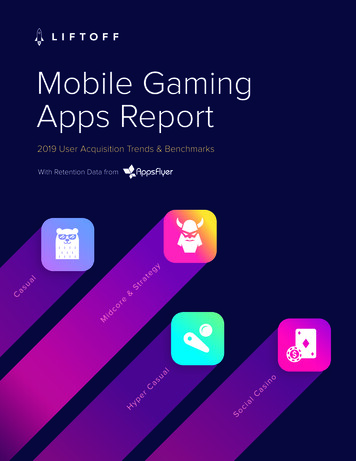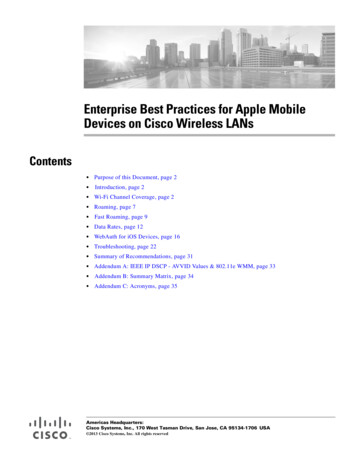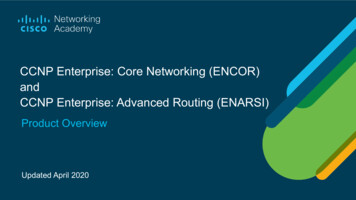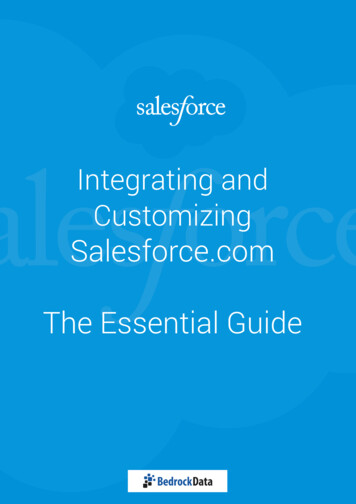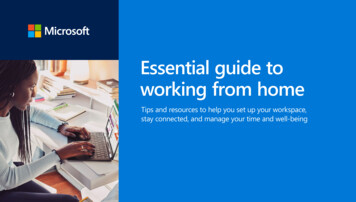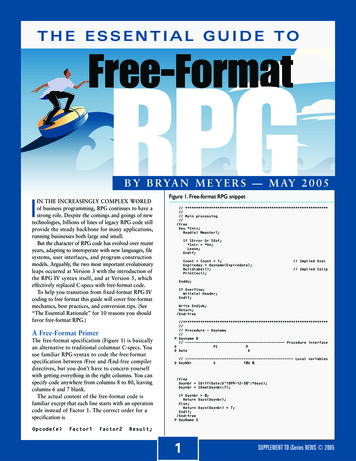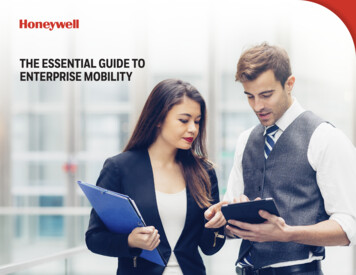
Transcription
THE ESSENTIAL GUIDE TOENTERPRISE MOBILITY
1The Essential Guide to Enterprise Mobility Table of Contents CHAPTER ONE1335CHAPTER FIVE42CHAPTER SIX48CHAPTER SEVEN55CONCLUSIONEnterprise Mobility Planning:Why a mobility strategy mattersCHAPTER TWOMobile Application Development:Why app decisions may be themost important ones you make20CHAPTER THREE28CHAPTER FOUREnterprise Mobility Deployment:How to get deployment rightMobile Security:How to determine which path yourmobile security strategy takesMobility Management: How toaddress management challengesin a modern mobile landscapeMobile Workforce Support:Why the right support setup mattersMobility Intelligence, Monitoringand Analytics: Why you shouldextend business intelligenceinto the mobile space
The Essential Guide to Enterprise Mobility Introduction lying cars, robotic housemaids, farming on the moon? Needless tosay, the 1950s view of the future hasn’t fully materialized. But when youconsider the first mobile phones – those enormous heavy bricks thatonly the elite could afford – it’s amazing to see how far we’ve come.
The Essential Guide to Enterprise Mobility Introduction www.honeywell.com/enterprisemobilitySome of the mobile capabilities that we now take for granted weren’teven a possibility a few decades ago. Yet scientists and engineerscontinue to push the envelope, bringing us an ever-growing numberof mobile device types, enterprise apps and unique ways to straddlethe corporate and personal worlds.There has already been an upsurge in innovativeadvancements such as wearables, with scifi-inspired gadgets available for purchase atall kinds of retailers. The trend toward cloudservices will continue, but with an emphasis onmobile devices and apps for easy access to filesfrom anywhere. Malware on mobile devices isgrowing, the mobile device management (MDM)market is consolidating and we’re seeing anincreased MDM focus on helping organizationsgrow the return on their mobility investments.So how do you ensure that your mobile infrastructureis ready for whatever comes next? If you put in thestrategic thinking and hard work now, you can resteasier knowing that your mobile environment is doingeverything possible to foster employee productivity,increase responsiveness to customers and conservecosts. Read on to learn more about everythingfrom strategic planning for the mobile landscapeto supporting the revolving door of devices, appsand content. See how the separate componentsof your mobile infrastructure can work togetherto help you achieve a holistic environment thatbenefits you, your employees and your customers.Nobody really knows which notions of the futurewill come to pass. But savvy IT professionals willtake advantage of today’s mobile possibilitieswhile preparing their organizations for whatevercomes flying down the road tomorrow. Be ready.3
The Essential Guide to Enterprise Mobility Chapter One www.honeywell.com/enterprisemobilityEnterprise Mobility PlanningWHY A MOBILITY STRATEGY MATTERSMobility is all about responsiveness, productivity and efficiency. Butjumping into the sea of mobility without strapping on a life jacketwon’t help your company swim faster or even stay afloat.4
5The Essential Guide to Enterprise Mobility Chapter One www.honeywell.com/enterprisemobilityLOOK BEFORE YOU LEAP: WHY A MOBILITY STRATEGY MATTERSMobility is all about responsiveness, productivity and efficiency. But jumping into the sea of mobility withoutstrapping on a life jacket won’t help your company swim faster or even stay afloat. You need to define yourenterprise mobility strategy, which means stepping back and taking the time necessary to get it right, both fortoday and for tomorrow. After all, without a strategy, you may be not only wasting money and duplicating effortbut also putting your corporate data, business customers and long-term business goals at risk.ALIGNMENT ADJUSTMENTTHINKING AHEADIf you don’t consider your overall business goalsas you develop a mobility strategy, you riskinvesting in mobile technology for mobility’s sakealone. Your mobile environment doesn’t exist in avacuum. Employees who use mobile devices alsoneed to use line-of-business apps, data storedon the corporate network and numerous othertools to do their work. By aligning your mobilitystrategy with the rest of your business, you’llcreate happier employees and customers.Smart decisions make it easier to adapt over timewhile keeping a lid on costs. Skyrocketing mobilitycosts is a common fear for CIOs, but careful planningwill help keep your mobility spend safely earthbound.Also consider the flip side. If you’re makingother kinds of changes to your IT environment,remember to take mobility into account.It’s tempting to race in and grab the latest and greatestdevices, but taking the time to form a comprehensivestrategy will result in long-term benefits. That planningmay include some up-front costs – such as consultingfees if you choose to work with an outside mobilitystrategist – but a small investment now will yield largedividends later in the form of heightened employeeproductivity, streamlined management and the abilityto take advantage of economies of scale.MOBILE ACCESS ENGAGEMENT REVENUE“ The mobile Internet ecosystem is fragmented, under-serving the needs of people, businesses and brands. ”– MOBILE WORLD CONGRESS, 2015
The Essential Guide to Enterprise Mobility Chapter One www.honeywell.com/enterprisemobilityMAP YOUR PATH: HOW TO ESTABLISH THE RIGHT STRATEGYGone are the days when mobility involved simply choosing a standardized device. Today, you have to think aboutnot just devices but also apps, data, storage, management (of devices, apps, content and telecom expenses)and support. Each plays an integral part of a successful mobility strategy.TAKE STOCKGRASSROOTS SUPPORTBefore you start to make purchasing decisions, youneed a true understanding of your current state,including your application architecture and yourbusiness requirements. Without knowing what youhave, you won’t be able to make sound financialdecisions about what you need. Analyze yourinfrastructure and processes and consider howyou’d like to translate them into the mobile world.Think about your existing technology investmentsand those that could apply to your mobile strategy.When it comes to establishing a mobility strategy,you can’t go it alone. Soliciting buy-in from keystakeholders results in a larger pool of ideas, greateradoption and less frustration later. Get input fromall angles by forming a cross-functional team tohelp determine what makes your business tick.Working together will also give you a strongersense of the specific issues and opportunitiesthat your mobile strategy should address.Of course, it’s also important to evaluate yourcompetition and what’s going on in your industryin terms of enterprise mobility. Is a cool app fromone of your competitors leeching away your marketshare? How can you capture the interest of theircustomers and make sure to keep your own? Knowingwhat other companies are doing – seeing whatworks and, perhaps more important, what doesn’twork – can help shape your own mobility goals.Have your team identify all the ways thatdifferent roles in your workforce currently usemobility, and explore other areas that are ripe forenhancement. Together, you’ll get a completeview of how many ways mobility could playa positive role in your company’s future.6
7The Essential Guide to Enterprise Mobility Chapter One www.honeywell.com/enterprisemobilityDIVISIVE DEVICESIt’s a given that stakeholders will have strongopinions about which devices are right for them.And with new devices flooding the market everyyear, it can be a balancing act to stay currentwithout breaking the bank. One of the most criticaldecisions that many companies have to make iswhich mobile platform to choose. Establishing astandardized platform helps other elements – suchas apps and support – fall into place with minimalhassle. The bring-your-own-device (BYOD) modelis growing in popularity, and it can spare you somedifficult decisions, but it also presents a wholeseries of considerations: How expensive will it beto support a BYOD program? How does our BYODprogram affect our ability to provide custom apps?Should we use stipends to help users acquire theirown devices and plans? Are we opening ourselvesup to potential legal ramifications? Do we needadditional security software to help mitigate risks?DOWNLOAD HONEYWELL’SBYOD POLICY TEMPLATE FOR: A comprehensive list of key elementsto include in your policy“ 2015 will be the year of Tips on stronger security for your mobile enterprisethe mobile app. With one Guidance on how a BYOD policy cansave you time and moneyin five tablet purchases Ways to realize the full potentialof your BYOD environmentIf you opt for a corporate, non-BYOD approach,you’ll need to determine the right platform andrecognize which devices straddle the fine linebetween cost-effective use of company resourcesand user acceptability. After all, if employeesdon’t like the devices you choose, they won’t usethem, which would be a waste of time, energyand budget. Putting into employees’ handsdevices that tie into your existing infrastructure,run necessary apps and heighten productivitywill have a major influence on adoption.being for enterprise usealone, the numbers backus up IT organizationswill dedicate at least 25percent of their softwarebudgets to mobileapplication development,deployment andmanagement by 2017. ”– ORRIN BROBERG, App Data Room
8The Essential Guide to Enterprise Mobility Chapter One www.honeywell.com/enterprisemobilityAN APP A DAYMore and more, software companies are investingin mobile versions of their enterprise apps, but thatdoesn’t necessarily mean those apps are right for you.Having native compatibility between desktop andmobile devices seems logical, but you have to makesure that those mobile apps meet your company’sneeds. It may be that other off-the-shelf apps makemore sense, or you may want to develop your own.Would it work best to use the cloud to serve upyour apps? Do you plan to virtualize them? Doyou want to provide for a range of platforms?Knowing the answers to these questions will helpyou formulate a mobile app strategy that willserve you well both now and in the future.PROTECT THE CROWN JEWELSIf desktop security breaches make you needto breathe into a bag, imagine the risksinvolved in putting corporate data on devicesthat employees take on business trips, out tolunch and even on vacations. Safeguardingthose devices – and the data that’s stored onthem – should be among your highest priorities.Here’s the good news: Devices and mobile softwareapps now include more security features than everbefore, so it’s easier to lock down devices, wipe themif they get lost or stolen, and establish appropriatecheckpoints to secure access to corporate data.Mobility management solutions (includingmobile device management, mobile applicationmanagement and mobile content managementtools) offer additional layers of security, so you cantailor settings and access to your users, devicesand apps based on the sensitivity of your data.Plus, the industry is adapting with comprehensivesecurity solutions like Samsung Knox, recently madeavailable to all users on any Samsung device.A secure BYOD environment mustachieve the following goals: Space isolationCorporate data protectionSecurity policy enforcementTrue space isolationNonintrusivenessLow resource consumptionDID YOU KNOW?According to Gartner,BYOD is growingfast – by 2016, 38percent of companieswill stop providing theiremployees with devices.By 2017, the same surveypredicts, that figurewill rise to 50 percent.
9The Essential Guide to Enterprise Mobility Chapter One www.honeywell.com/enterprisemobilityIT’S POLICY“Policy” can be a dirty word in the IT realm, butputting the right policies in place can be critical tosuccessful enterprise mobility. They can make adifference in ease of use, cost, IT control, security the list goes on. Make sure you’re clear on yourpolicy goals, because it’s easy to lose sight of thefact that you are trying to protect content, and findyourself concentrating on cost savings instead. Decide on relevant acceptable-usepolicies to determine which apps areapproved and which are blacklisted. Make certain that sensitive data isproperly encrypted and available onlyto those who should have it. Do everything you can to ensure that your devicesdon’t provide an open door to your corporate data.The more you lock down your devices, appsand content, the less freedom your employeeshave. While slowing down employees too muchcan have a negative effect on their productivity,making them think before barreling ahead in aninsecure direction can be worth a small hassle.But try to avoid presenting policy hurdles that aretoo big, because they tend to result in users whowork around – rather than within – your setup. Beas transparent about your policies as possible.Employees need to know what’s fair game andwhat’s off-limits, and they also should be awareof the company’s rights and responsibilities(and their own) if a device is compromised.BE SUPPORTIVEAdding a mobile infrastructure – especially if you havea BYOD program, with its myriad device types andplatforms – can overload a helpdesk, and IT staff maybe ill-equipped to deal with mobility issues. Be awareof your support structure and bandwidth constraints,and make sure that you have enough of the right kindof expertise sitting at your helpdesk. And, becausethe whole idea of mobility is to be able to work fromanywhere at any time, you’ll truly need 24x7 support.You may decide that training your current helpdeskstaff makes sense, and you may even need toadd a few heads to the group. (Remember, it’s notuncommon for employees to have more than onemobile device, so the uptick in support demandsmay be even steeper than you anticipate.) Manycompanies decide that their mobile environmentsrequire a dedicated leader, board or team beyondthe helpdesk, and some opt to turn over supportentirely, relying instead on expert outsourcedpartners for more consistent costs and service.DID YOU KNOW?BYOD policies create aninsecure environment, asthe corporate network isextended and becomesharder to protect fromattacks. In this scenario,corporate informationcan be leaked, personaland corporate spacesare not separated, itis difficult to enforcesecurity policies onthe devices, andemployees are worriedabout their privacy.
10The Essential Guide to Enterprise Mobility Chapter One www.honeywell.com/enterprisemobilityKEEP TABSOnce you’ve done the heavy lifting and have yourmobile environment up and running smoothly, makesure it stays that way. Lots of organizations overlookthe importance of monitoring; including monitoringservices in your initial strategy ensures that yourmobile environment will keep working for you.Make sure you properly handle posture monitoringso that you know how many of your devices arequarantined, part of a BYOD program and so on.Just as the car that was state of the art a decadeago no longer turns heads, advancements in mobiletechnology make today’s must-have features oldnews pretty quickly. If you continuously monitoryour device and app usage, you’ll have insightsinto which investments are paying off and whichare no longer necessary. At the same time, bykeeping an eye out for new technologies, you cantake advantage of efficiencies across your mobileenterprise. To really get the most out of your mobileenvironment, also monitor security and costs – manycompanies use telecom expense management (TEM)software to track and manage wireless assets.DID YOU KNOW?Given that mobility isa key enabler of digitalbusinesses, it shouldcome as no surprise thatmobility is a strong areaof focus for all typesof companies. Indeed,4 in 10 companiesindicated that they haveaggressively pursuedand invested in mobiletechnologies acrosstheir business, and thatthey consider mobilityto be a key part of theirbusiness strategy.
11The Essential Guide to Enterprise Mobility Chapter One www.honeywell.com/enterprisemobilityTRACK MOBILITY TRENDS: WHAT TOWATCH FOR AS YOU MOVE FORWARDSpeaking of trends and taking advantage of them, here are a fewthings to keep in mind as you embark on your mobility journey:Relevant apps. It used to be the devices that gotall the attention, but apps now play a greater role instrategic decision making.Forrester notes that 35 percent of large enterpriseswill use mobile application development platformsto develop and deploy mobile apps across theirorganizations in 2015. By 2017, 100 percent ofline-of-business (LOB) apps in internally facingroles will be built for mobile-first consumption.Keeping up with devices. For plenty of employees,having a smartphone isn’t enough. They alsowant the option to use a laptop, a tablet or evena multimedia player. As other devices and relatedtechnologies emerge, such as sensor fusion and theApple Watch , companies need to stay aware of thechanging landscape.The move to HTML5. Although native appsusually provide a greater experience than webapps, web apps using HTML5 are closing thegap and have the benefit of running on multiplemobile platforms. Because some apps arebest suited for native environments and otherswork better as web apps, many companies areconsidering hybrid apps as a compromise thatmeets the needs of both developers and users.Cloud and virtualization. A growing number ofcompanies are turning to cloud-based mobile appsand virtualized apps to store data more securely.The cloud provides added incentives, includingaccessibility to data from multiple devices, low costsand increased performance speed.DID YOU KNOW?In a recent Accenturestudy, 62 percent ofrespondents saidthat adopting cloudtechnology is animportant priority. Thesame survey foundthat nearly half want toimprove their apps, witha focus on reliabilityand user satisfaction.
12The Essential Guide to Enterprise Mobility Chapter One www.honeywell.com/enterprisemobilityBYO According to a survey by analyst house Ovum,74 percent of employees use personal devices, appsand other technology at work, essentially bringingthem in behind the IT department’s back. Faced withthis reality, many companies are embracing BYODas more than just a passing fad, and they’re evengoing beyond it to include other personal resources.Social media. Twitter and its counterparts aren’tjust for teenagers anymore. Companies use socialmedia to improve collaboration among employees,build a cohesive brand and celebrate business wins.Business intelligence (BI). Using mobile devices forvisualization and analysis is becoming increasinglycommon as software developers bring big datato small screens, using the cloud to store theinformation required to deliver BI insights.With strategic planning and a forwardlooking attitude, you’ll be able to properlynavigate the seas of mobility.SOURCES1. Mobile Apps Increase Enterprise Performance and Productivity Advantages,Top Three Mobile App Strategies Gain MomentumFOLLOW US:6. ZDNet, Adopting BYOD2. The Rise of Mobile7. University of Nebraska, Remote Mobile Screen: AnApproach for Secure BYOD Environments3. Ovum: BYOD Is Here to Stay8. App Data Room, Honeywell Facts4. 15 Tech Trends to Emerge by 20149. Accenture Digital, Growing the Digital Business, Accenture Mobility Research5. Combining ISMS with Strategic Management: The Case of BYOD10. Accenture, Mobility: Fueling the Digital Surge
The Essential Guide to Enterprise Mobility Chapter Two www.honeywell.com/enterprisemobility13Mobile Application DevelopmentWHY APP DECISIONS MAY BE THE MOST IMPORTANT ONES YOU MAKEToday’s employees want more – and they need more – if they’re goingto stay productive from anywhere, which tends to be the primarygoal of having mobile devices i
WHY A MOBILITY STRATEGY MATTERS Mobility is all about responsiveness, productivity and efficiency. But . enterprise mobility strategy, which means stepping back and taking the time necessary to get it right, both for today and for tomorrow. After all, without a strategy, you


